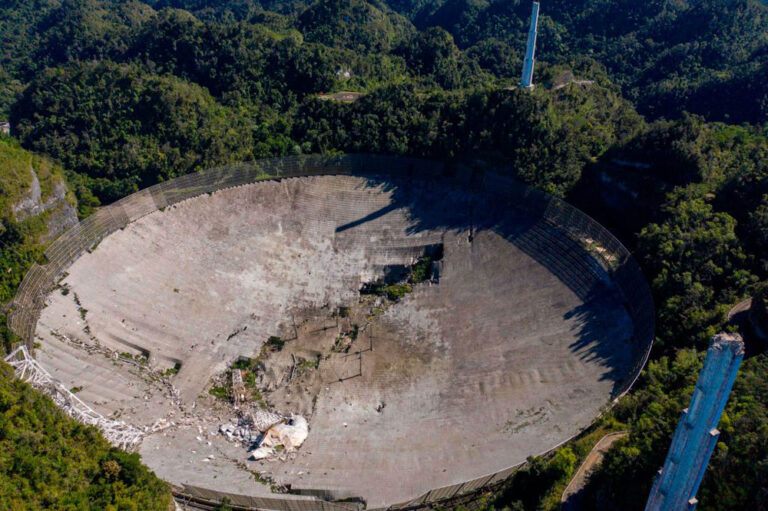

It also seeks the implementation of a research and workforce development program, with the centre slated to open next year in the northern mountain town of Arecibo where the telescope was once located. Instead, the agency issued a solicitation for the creation of a $5-million education centre at the site that would promote programs and partnerships related to science, technology, engineering and math. The venerable radio telescope and observatory may be temporarily down for now, but don't count it out just yet.The National Science Foundation announced Thursday that it will not rebuild a renowned radio telescope in Puerto Rico, which was one of the world's largest until it collapsed nearly two years ago. Arecibo has even turned up on the big screen, in the movies Contact and Golden Eye. Arecibo has also played a key role in the Search for Extraterrestrial Intelligence (SETI) over the years, collecting data for the project and broadcasting a message to the globular cluster Messier 13 in Hercules in 1974. The dish has been used to probe Earth’s ionosphere, image and characterize near-Earth asteroids, examine distant pulsars, galaxies, and more. Over the years, Arecibo has proved to be a powerful tool for radio astronomy. The Arecibo dish was the largest radio telescope for over half a century, until China’s Five-hundred meter Aperture Spherical Telescope (FAST) dish came online in 2016. That storm damaged the line feed to the main dish, which also took out some of the main dish panels below when it fell.īuilt over a natural sink hole, Arecibo began operations in 1963. The dish also sustained damage in 2017 when Hurricane Maria devastated Puerto Rico. Nevertheless, funding issues have continued to plague the observatory.

Reduced funding, proposed by the NSF in 2007, would have ultimately shuttered Arecibo, but astronomers, members of the Planetary Society, and others mobilized to protect the facility. The National Astronomy Ionosphere Center uses the facility, and NASA uses Arecibo's radar for asteroid recon.Īrecibo has faced calamity before. Méndez based in San Juan, Puerto Rico and Yang Enterprises Inc. The University of Central Florida (UCF) manages the National Science Foundation (NSF) facility in partnership with the Universidad Ana G.
Arecibo telescope damage by maria full#
“We have a team of experts assessing the situation,” says Arecibo Observatory director Francisco Cordova in a recent press release “Our focus is assuring the safety of our staff, protecting the facilities and equipment, and restoring the facility to full operations as soon as possible.” Looking across the walkway towards the central platform at Arecibo's focus. What caused the cable to snap isn’t immediately clear engineers are still gauging the damage and the time needed for repairs. The cable fell on the main reflector dish, opening up a 100-foot long gash. When the cable snapped, it twisted the platform, and damaged six to eight panels on the suspended dome. The platform is anchored to three towers around the edge of the dish. Damage to the main dish, as seen from the ground.
Arecibo telescope damage by maria upgrade#
The auxiliary cables and the Gregorian dome were added in an upgrade completed in 1997, and were expected to last 50 years. The telescope is situated at latitude 18.3°N, and its dish is pointed straight at the zenith, but thanks to the beam-steering mechanism near its focus, Arecibo can aim at a swath 20° north-to-south on either side of zenith, expanding its view considerably. The platform houses the radio dish's beam-steering mechanism, a Gregorian reflector system that focuses incoming radio waves. The cable is one of four auxiliary cables per tower that support a triangular platform over the dish. No personnel were injured in the incident. local time, when a three-inch-thick cable snapped and fell to the dish below. The damage occurred on Monday, August 10th, at 2:45 a.m. Now Arecibo has suffered damage caused when one of its auxiliary support cables snapped, bringing operations at the observatory to a halt. Just over the past few years, the giant 1,000-foot diameter radio telescope weathered severe budgetary woes and survived a direct hit from the Category 4 Hurricane Maria, for which repairs are still ongoing.

The Arecibo Observatory in Puerto Rico, one of the world's largest radio telescopes, has had its share of rough times, including earthquakes and hurricanes. Cables support a triangular platform over the dish, which in turn supports a beam-steering mechanism housed in the dome seen hanging below the platform. An overview of the Arecibo radio telescope.


 0 kommentar(er)
0 kommentar(er)
